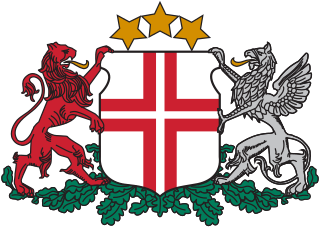
The Kriegsmarine was the navy of Nazi Germany from 1935 to 1945. It superseded the Imperial German Navy of the German Empire (1871–1918) and the inter-war Reichsmarine (1919–1935) of the Weimar Republic. The Kriegsmarine was one of three official branches, along with the Heer and the Luftwaffe, of the Wehrmacht, the German armed forces from 1935 to 1945.

HMS Defiance was a 74-gun third rate ship of the line of the Royal Navy, built by Randall and Co., at Rotherhithe on the River Thames, and launched on 10 December 1783.

A training ship is a ship used to train students as sailors. The term is mostly used to describe ships employed by navies to train future officers. Essentially there are two types: those used for training at sea and old hulks used to house classrooms. As with receiving ships or accommodation ships, which were often hulked warships in the 19th Century, when used to bear on their books the shore personnel of a naval station, that were generally replaced by shore facilities commissioned as stone frigates, most "Training Ships" of the British Sea Cadet Corps, by example, are shore facilities.

USS Point Defiance (LSD-31) was a Thomaston-class dock landing ship of the United States Navy. She was named for Point Defiance, a location in Pierce County, Washington, the site of a military reservation established by the U.S. Government in 1866. She was the second ship assigned that name. The construction of the first ship, Casa Grande-class dock landing ship Point Defiance (LSD-23), was canceled on 17 August 1945.

A ship is scuttled when its crew deliberately sinks it, typically by opening holes in its hull.

Naval Station Argentia is a former base of the United States Navy that operated from 1941 to 1994. It was established in the community of Argentia in the Dominion of Newfoundland, which later became the tenth Canadian province, Newfoundland and Labrador.

The action of August 1702 was an inconclusive naval battle that took place from 19 to 25 August 1702 O.S. between an English squadron under Vice-Admiral John Benbow and a French under Admiral Jean du Casse, off Cape Santa Marta on the coast of present-day Colombia, South America, during the War of the Spanish Succession. Benbow vigorously attacked the French squadron, but the refusal of most of his captains to support the action allowed du Casse to escape. Benbow lost a leg during the engagement and died of illness about two months later. Two of the captains were convicted of cowardice and shot.

The Naval General Service Medal (NGSM) was a campaign medal approved in 1847, and issued to officers and men of the Royal Navy in 1849. The final date for submitting claims was 1 May 1851. Admiral Thomas Bladen Capel was one of the members of the board that authorised the medal.

The Apollo class were second-class protected cruisers designed by Sir William White and built for the Royal Navy in the late 19th century. Twenty-one ships of this class were built, making it the largest single class of steel cruisers ever built for the Royal Navy to the same design.

HMS Defiance was the last wooden line-of-battle ship launched for the Royal Navy. She never saw service as a wooden line-of-battle ship. In 1884 she became a school ship.

USS Oswald A. Powers (DE-542) was a United States Navy John C. Butler-class destroyer escort launched during World War II but never completed.

The United States Navy (USN) is the maritime service branch of the United States Armed Forces and one of the eight uniformed services of the United States. It is the world's most powerful navy and the largest by tonnage, at 4.5 million tons in 2021 and in 2009 an estimated battle fleet tonnage that exceeded the next 13 navies combined. It has the world's largest aircraft carrier fleet, with 11 in service, one undergoing trials, two new carriers under construction, and six other carriers planned as of 2024. With 336,978 personnel on active duty and 101,583 in the Ready Reserve, the U.S. Navy is the third largest of the United States military service branches in terms of personnel. It has 299 deployable combat vessels and about 4,012 operational aircraft as of July 18, 2023.

Latvian Naval Forces is the naval warfare branch of the National Armed Forces. It is tasked with conducting military, search and rescue operations, mine and explosive sweeping on the Baltic Sea, as well as ecological monitoring activities. The Naval Forces have participated in international NATO/Partnership for Peace operations and various exercises with great success. The main development priorities of the Naval Forces are to expand their activities within the Baltic States’ Ship Squadron BALTRON and to develop a Sea Surveillance System. They pay a great deal of attention to professionally specialized training and English-language teaching.

The first USS Defiance (ID-3327) was a cargo ship in the United States Navy during World War I.

USS Defiance (PGM-95/PG-95) was a gunboat in the United States Navy and later transferred to Turkey. She was an Asheville-class gunboat, and the third ship to be named Defiance, in honor of the city of Defiance, Ohio.

The action of 8 June 1755 was a naval battle between France and Great Britain early in the French and Indian War. The British captured the third-rate French ships Alcide and Lys off Cape Ray, Newfoundland in the Gulf of St. Lawrence. The battle contributed to the eventual war declarations that in 1756 formally began the Seven Years' War.

Operation Postmaster was a British special operation conducted on the Spanish island of Fernando Po, now known as Bioko, off West Africa in the Gulf of Guinea, during the Second World War. The mission was carried out by the Small Scale Raiding Force (SSRF) and the Special Operations Executive (SOE) in January 1942. Their objective was to board the Italian and German ships in the harbour and sail them to Lagos. The SSRF under the command of Major Gus March-Phillipps left Britain in August 1941 and sailed the Brixham trawler, Maid of Honour, to the Spanish colony.
Iserlohn was a 4,667 GRT cargo ship that was built in 1909 by Reiherstieg Schiffswerfte & Maschinenfabrik, Hamburg, Germany. She was ceded to the United Kingdom in 1919, passing to the Admiralty. In 1921, she was sold into merchant service and renamed Union City. She was sold to Finland in 1924 and renamed Wasaborg. In 1935, she was sold to Italy and renamed Erica. In 1940, she was seized by the United Kingdom and passed to the Ministry of War Transport (MoWT). Renamed Empire Defiance, she served until June 1944, when she was sunk as a blockship at Sword, Ouistreham, France in support of Operation Overlord. She was salvaged in 1951 and scrapped at Antwerp, Belgium.

HMS Rhododendron was a Flower-class corvette that served with the Royal Navy during the Second World War. She served as an ocean escort in the Battle of the Atlantic.

















